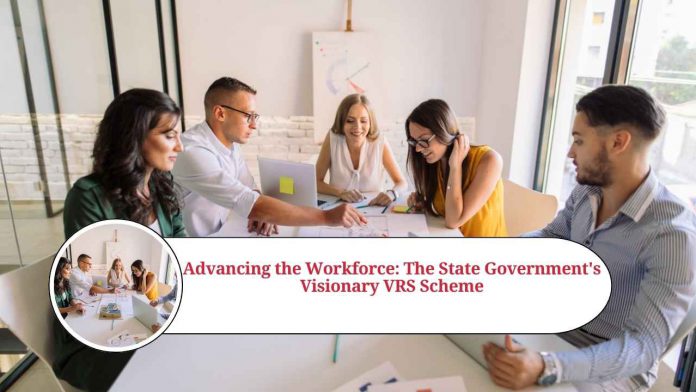In a progressive move towards enhancing administrative efficiency and workforce optimization, state governments across the nation have introduced the visionary Voluntary Retirement Scheme (VRS) for their employees. This unique initiative aims to provide eligible government employees with an opportunity to gracefully exit their roles while also allowing the government to streamline its operations and promote better resource allocation. This article explores the key features and benefits of the VRS scheme, shedding light on its implications for both employees and the state government.
I. Understanding the Voluntary Retirement Scheme (VRS)
A. Definition and Purpose
The VRS scheme refers to a voluntary exit plan offered by state governments to their employees, allowing them to retire from their positions before attaining the statutory age of superannuation. The primary objective of this scheme is to optimize human resource utilization, align workforce strength with evolving demands, and create opportunities for younger talent to join the government workforce.
B. Eligibility Criteria
To be eligible for the VRS scheme, government employees must meet certain criteria, including minimum years of service, proximity to the superannuation age, and compliance with the rules set by the state government. These criteria ensure that the scheme targets employees who are willing and able to transition from their current roles.
II. Key Features of the VRS Scheme
A. Financial Incentives
The VRS scheme offers attractive financial benefits to employees who opt for voluntary retirement. These benefits may include a lump-sum payment based on the years of service, pension and gratuity calculations, and other retirement benefits as per the existing norms. By providing financial incentives, the scheme encourages eligible employees to consider retirement while mitigating concerns about post-retirement financial security.
B. Rejuvenation of the Workforce
One of the significant advantages of the VRS scheme is the opportunity it creates for the government to rejuvenate its workforce. By allowing experienced employees to retire, the government can infuse fresh talent and ideas, foster innovation, and adapt to the changing needs of governance. This helps create a dynamic and vibrant work environment that promotes efficiency and effectiveness.
III. Benefits and Implications of the VRS Scheme
A. Enhanced Efficiency and Resource Optimization
The VRS scheme facilitates the rationalization of the government workforce, leading to improved efficiency and optimal resource allocation. By strategically managing retirements and departures, departments can redistribute workload, restructure teams, and identify areas where additional resources are required. This promotes a more productive and streamlined administration, ultimately benefiting the citizens through better service delivery.
B. Cost Savings
Through the VRS scheme, state governments can achieve significant cost savings in the long run. While the immediate expenditure on retirement benefits is inevitable, the reduced salary and benefits obligations for retiring employees result in substantial financial relief for the government. These savings can be redirected towards essential sectors such as education, healthcare, infrastructure development, and social welfare programs.
C. Succession Planning and Skill Development
The VRS scheme provides an opportunity for the government to proactively plan for succession and skill development. By encouraging the exit of senior employees, the government can identify potential successors, groom emerging leaders, and bridge competency gaps through training and capacity-building initiatives. This strategic approach ensures the continuity of operations and the smooth transition of responsibilities.
The Voluntary Retirement Scheme (VRS) for state government employees represents a remarkable step towards aligning the workforce with the evolving needs of governance. By providing financial incentives and rejuvenating the workforce, this visionary scheme drives administrative efficiency, optimal resource utilization, and cost savings. The VRS scheme also enables succession planning and skill development, fostering a sustainable work environment. As state
Read more useful content:
FAQs
Q1: What is the Voluntary Retirement Scheme (VRS) for state government employees?
A1: The VRS scheme is a voluntary exit plan introduced by state governments that allows eligible government employees to retire from their positions before reaching the statutory age of superannuation. It aims to optimize human resource utilization, streamline operations, and create opportunities for new talent to join the government workforce.
Q2: Who is eligible for the VRS scheme?
A2: Eligibility criteria for the VRS scheme may vary across state governments. However, common requirements include minimum years of service, proximity to the superannuation age, and compliance with the rules set by the respective state government. These criteria ensure that the scheme targets employees who are willing and able to transition from their current roles.
Q3: What financial benefits are provided under the VRS scheme?
A3: The VRS scheme offers attractive financial incentives to employees who opt for voluntary retirement. These benefits may include a lump-sum payment based on the years of service, pension and gratuity calculations, and other retirement benefits as per the existing norms. The financial incentives are designed to encourage eligible employees to consider retirement while ensuring their post-retirement financial security.
Q4: How does the VRS scheme benefit the state government?
A4: The VRS scheme offers several benefits to the state government. Firstly, it helps enhance administrative efficiency and resource optimization by allowing the rationalization of the workforce. Departments can redistribute workload, restructure teams, and identify areas where additional resources are needed, leading to improved productivity and service delivery. Secondly, the scheme enables significant cost savings in the long run by reducing salary and benefits obligations for retiring employees. These savings can be redirected towards priority sectors such as education, healthcare, and infrastructure development. Finally, the VRS scheme promotes succession planning and skill development by creating opportunities for emerging leaders and bridging competency gaps through training initiatives.
Q5: How does the VRS scheme contribute to rejuvenating the workforce?
A5: The VRS scheme plays a crucial role in rejuvenating the workforce by allowing experienced employees to retire. This creates opportunities for the government to infuse fresh talent and ideas, fostering innovation and adaptability to changing governance needs. The presence of a dynamic and vibrant workforce promotes efficiency and effectiveness in the administration.
Q6: Does the VRS scheme impact the continuity of operations?
A6: The VRS scheme includes provisions for succession planning and skill development, ensuring the continuity of operations. By encouraging the exit of senior employees, the government can identify potential successors, groom emerging leaders, and bridge competency gaps through training and capacity-building initiatives. This strategic approach helps in the smooth transition of responsibilities and minimizes disruptions in the workflow.
Q7: Is participation in the VRS scheme mandatory for eligible employees?
A7: No, participation in the VRS scheme is entirely voluntary for eligible government employees. The scheme is designed to offer employees a choice to retire early if they wish to do so, considering their individual circumstances and career aspirations. Employees have the freedom to evaluate the benefits and implications of the scheme and make an informed decision based on their personal preferences.
Q8: How can employees find more information about the VRS scheme?
A8: Employees who are interested in the VRS scheme can obtain more information from their respective state government’s human resources department or the designated authority responsible for implementing the scheme. These departments will provide details on eligibility criteria, financial benefits, the application process, and any other relevant information regarding the scheme.




















